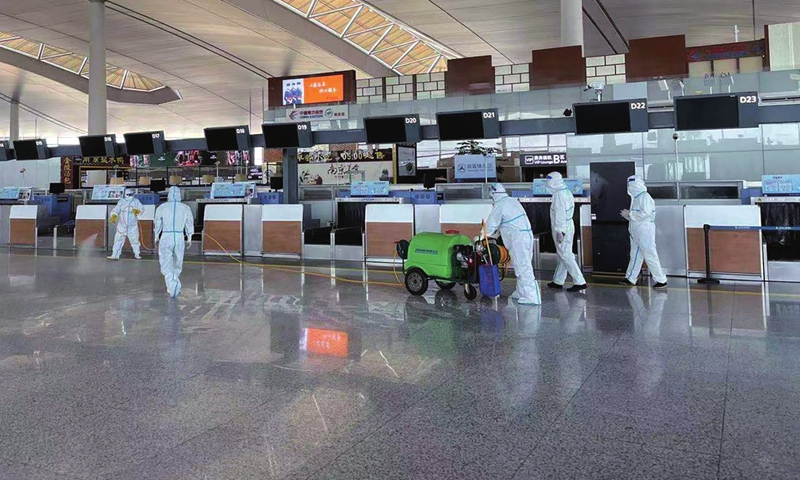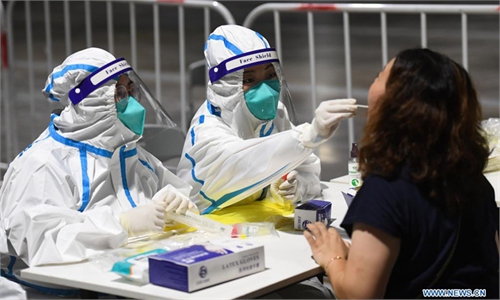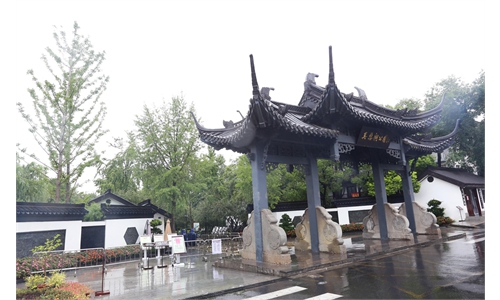More places enhance steps amid new Nanjing outbreak
Should be warning signal to cities amid Delta transmission: experts

Staff members carry out sterilization work at the Terminal 2 of Nanjing Lukou International Airport in Nanjing, East China's Jiangsu Province on Wednesday after 17 airport workers tested positive for the COVID-19. Photo: Xinhua
The COVID-19 outbreak in Nanjing, capital of East China's Jiangsu Province, continues to escalate at an unpredicted speed due to the high population flow of the airport and the strong transmission capacity of the Delta variant.
While calling for the city to enhance anti-epidemic measures and accelerate epidemiological surveys, Chinese experts are also taking the outbreak as an example of how some Chinese cities have become slack at anti-epidemic work.
Jiangsu reported 48 new confirmed cases and one asymptomatic case on Wednesday, taking the total number of infections in the province to 159 since July 20. Wang Hecheng, a deputy director of the National Health Commission and director of the national administration of disease prevention and control, has arrived in Jiangsu to guide the anti-epidemic work.
The infections in Nanjing were nearly all found in areas near the Lukou International Airport, where the outbreak started, Nanjing health authority official Yang Dasuo said on Wednesday at a press conference.
Nanjing kicked off the third round of citywide nucleic acid tests on Wednesday.
Jin Dongyan, a biomedical professor at the University of Hong Kong, told the Global Times on Wednesday that based on the information released by the Nanjing health authority, no large-scale case of transmission at a gathering has been found in the city.
But Nanjing should conduct and release more detailed epidemiological surveys on the existing cases, especially early cases detected at the airport, to find out how the first people got infected and how they transmitted the virus to others, such as by eating together or touching the same items, Jin suggested.
Only under this circumstance can the airport take specific measures to close the loopholes, he said.
Medical experts previously told the media that most of the cases in Nanjing had been vaccinated. However, the local authority revealed Wednesday that four of the cases in Nanjing had been classified as critical, which made netizens worry over the efficacy of vaccines.
Zhuang Shilihe, a Guangzhou-based expert, said that it is still not clear whether the four people had been vaccinated, and previous research had proven that vaccines were still the best method of preventing critical cases.
Zhuang estimated that the outbreak in Nanjing would last at least another two weeks, after comparing it with a previous outbreak in Guangzhou, Guangdong Province.
According to media reports, about 90 percent of the workers at the airport in Nanjing, or 5,036 people, had been vaccinated as of May.
Other cities in Jiangsu are reinforcing anti-pandemic measures. Suzhou has set up 18 highway checkpoints to check the health status of drivers coming from Nanjing. Suzhou has also suspended all passenger road transportation, including buses and taxis, with Nanjing.
The total number of cases related to the Nanjing outbreak has surpassed 170. Besides Jiangsu, cases have been reported in at least 10 cities in five provinces, including South China's Guangdong and Southwest China's Sichuan.
According to media reports, seven cases recently detected in Dalian, Liaoning and Chengdu, Southwest China's Sichuan recently had attended a same show in Zhangjiajie, Central China's Hunan Province, on July 22.
Among the seven cases, three discovered in Dalian had transferred at the Lukou Airport on July 17.
Zhangjiajie has screened for close contacts of those who attended the show, put them under quarantine, and collected their nucleic acid samples for testing.
The Sichuan provincial government has required all arrivals since Wednesday to undergo a 14-day quarantine at specified quarantine centers and another seven-day quarantine at home.
According to Jin, usually, the situation of the spill-over outbreak would not be severer than that in Nanjing unless some special situation, for example, a super virus spreader appears.
The Nanjing health authority has confirmed that the variant leading to the local outbreak is Delta, which replicates much faster, according to a recent study by Chinese experts. Individuals infected with Delta also had viral loads up to 1,260 times higher than those in people infected with the original strain, according to the study.
But Delta is not the only factor that led to the Nanjing outbreak's unpredictable expansion in terms of speed and impact. Experts and netizens pointed out that the Nanjing outbreak showed how some Chinese cities have become slack at anti-epidemic work, and this should be a wake-up call for all these cities.
The first batch of cases discovered was among cleaners at the Lukou Airport. At a meeting of Jiangsu provincial authorities on July 21, the airport failed to separate international airline operation from domestic ones, leading to possible imported outbreaks. The airport also failed to strictly manage its employees after discovering positive nucleic acid test samples.
According to media reports, the airport outsourced its cleaning to external companies, leaving a vacuum in the management of the cleaners. The companies, aiming to cut costs, did not arrange special personnel for cleaning work in areas and airlines of international flights.
Nanjing's performance in tackling this outbreak is disappointing, given the lessons drawn from previous lessons in Anhui, Guangdong and Yunnan provinces, Zhuang said, noting late moves to limit transportation and the slow release of results of epidemiological investigations.


